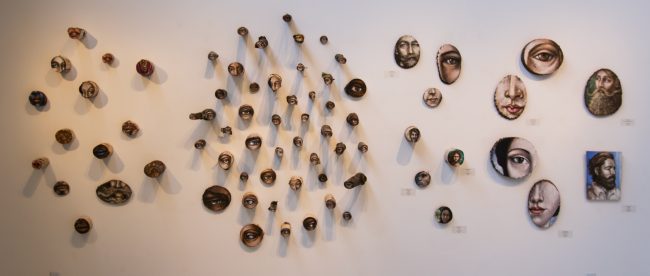View Nievert’s own “whimsical, imagined world”

Photo by Porcha Hesselgesser.

Photo by Porcha Hesselgesser
In October 2016, the Advocate did a feature on Mt. Hood’s newest full-time painting instructor, Matteo Neivert. This month, his artwork is being featured in the Visual Arts Gallery on campus.
The Advocate caught up with Neivert to get an update on the showing.
How many new pieces of art did you create for this show?
“That’s like asking my mother how old she is. In painting, even if a piece is several years old, I often paint on it and change it as it evolves over time. About three-quarters of the work is new. Only four or so large pieces are from a few years ago, but I also painted a bit on them, as well. Many pieces go through several changes and evolve over time but are considered new since I have just finished them – even though I started working on them a few years previously.
When you look at a Monet in a museum, often it says “Circa 1880-84,” meaning it took four years to complete the painting or it went through many changes until being shown for exhibit within that time span. Art is like a cake that never goes bad. Let’s say you make a chocolate cake and want to put roses on it and make it vanilla. You pull it out the painting of the cake and paint over it or alter it. You can also change it entirely.”
So, which ones are the truly new pieces?
“Many, too many to list… There are over 70 new paintings of eyeballs and faces alone in an installation piece; 12 more faces on porcelain plates. Many landscapes featuring icebergs in reflective pools of the ocean. Many new surreal paintings of barnacles dancing on water.”
Did all of your work in the gallery have a connecting theme?
“My overall theme is the human connection and disconnect with nature. Many pieces illustrate our deep connection with the natural world, and other paintings are fantasies within that concept. Sometimes a painting functions as a lamentation for the parts of ourselves that we lose when we disconnect with nature. I also like to explore objects such as icebergs which are temporary since they melt. Their beauty, like a rose, is not always long-lived.
Many topics are questions I seek answers for such as: What would the planet look like if we became extinct? How did life occur on earth? Does an inanimate object have a life force or energy, since it can be seen, observed, touched?…
Many things are fodder for my own whimsical, imagined world. Even when I paint serious subject matter, I feel it is important to have some whimsy, comedy, and lightheartedness.”
The time allotted to you since I first interviewed you and now is rather short. Was it difficult to produce the new work in that time?
“It was definitely a challenge to create so much work in a short span of time. I worked hard painting after work, late at night, and on the weekends. I had my own homework up to my ears!”
When did you finish the last piece before the showing?
“I finished the last painting, “Sandy Barnacle,” the day I delivered the paintings on Sunday, Feb. 5! I finished “Let Your Fingers Do The Walking” on Feb. 4.”

Leave a comment